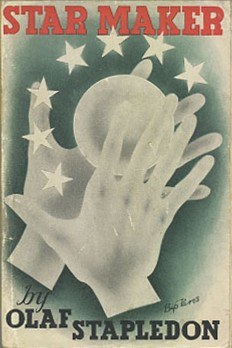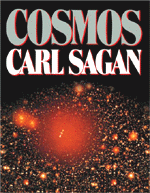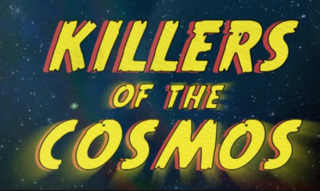
Exploring the Earth and the Cosmos is a book written by Isaac Asimov in 1982. [1]

Exploring the Earth and the Cosmos is a book written by Isaac Asimov in 1982. [1]

Ann Druyan is an Emmy and Peabody Award-winning American documentary producer and director specializing in the communication of science. She co-wrote the 1980 PBS documentary series Cosmos, hosted by Carl Sagan, whom she married in 1981. She is the creator, producer, and writer of the 2014 sequel, Cosmos: A Spacetime Odyssey and its sequel series, Cosmos: Possible Worlds, as well as the book of the same name. She directed episodes of both series.

Godzilla vs. Mothra is a 1992 Japanese kaiju film directed by Takao Okawara, written by Kazuki Ōmori, and produced by Shogo Tomiyama. Produced and distributed by Toho Studios, it is the 19th film in the Godzilla franchise, and is the fourth film in the franchise's Heisei era. The film features the fictional monster characters Godzilla, Mothra, and Battra, and stars Tetsuya Bessho, Satomi Kobayashi, Takehiro Murata, Megumi Odaka, Shiori Yonezawa, Makoto Otake, Akiji Kobayashi, Koichi Ueda, Shinya Owada, Keiko Imamura, Sayaka Osawa, Saburo Shinoda and Akira Takarada, with Kenpachiro Satsuma as Godzilla. The plot follows Battra and Mothra's attempts to stop Godzilla from attacking Yokohama.

The cosmos is another name for the Universe. Using the word cosmos implies viewing the universe as a complex and orderly system or entity.

Star Maker is a science fiction novel by British writer Olaf Stapledon, published in 1937. The book describes a history of life in the universe, dwarfing in scale Stapledon's previous book, Last and First Men (1930), a history of the human species over two billion years. Star Maker tackles philosophical themes such as the essence of life, of birth, decay and death, and the relationship between creation and creator. A pervading theme is that of progressive unity within and between different civilizations.

Cosmology is a branch of physics and metaphysics dealing with the nature of the universe. The term cosmology was first used in English in 1656 in Thomas Blount's Glossographia, and in 1731 taken up in Latin by German philosopher Christian Wolff, in Cosmologia Generalis. Religious or mythological cosmology is a body of beliefs based on mythological, religious, and esoteric literature and traditions of creation myths and eschatology. In the science of astronomy, cosmology is concerned with the study of the chronology of the universe.

Big History is an academic discipline which examines history from the Big Bang to the present. Big History resists specialization, and searches for universal patterns or trends. It examines long time frames using a multidisciplinary approach based on combining numerous disciplines from science and the humanities, and explores human existence in the context of this bigger picture. It integrates studies of the cosmos, Earth, life, and humanity using empirical evidence to explore cause-and-effect relations, and is taught at universities and primary and secondary schools often using web-based interactive presentations.

Cosmos is a popular science book written by astronomer and Pulitzer Prize-winning author Carl Sagan. It was published in 1980 as a companion piece to the PBS mini-series Cosmos: A Personal Voyage with which it was co-developed and intended to complement. Each of the book’s 13 illustrated chapters corresponds to one of the 13 episodes of the television series. Just a few of the ideas explored in Cosmos include the history and mutual development of science and civilization, the nature of the Universe, human and robotic space exploration, the inner workings of the cell and the DNA that controls it, and the dangers and future implications of nuclear war. One of Sagan's main purposes for both the book and the television series was to explain complex scientific ideas in a way that anyone interested in learning can understand. Sagan also believed the television was one of the greatest teaching tools ever invented, so he wished to capitalize on his chance to educate the world. Spurred in part by the popularity of the TV series, Cosmos spent 50 weeks on the Publishers Weekly best-sellers list and 70 weeks on the New York Times Best Seller list to become the best-selling science book ever published at the time. In 1981, it received the Hugo Award for Best Non-Fiction Book. The unprecedented success of Cosmos ushered in a dramatic increase in visibility for science-themed literature. The success of the book also served to jumpstart Sagan's literary career. The sequel to Cosmos is Pale Blue Dot: A Vision of the Human Future in Space (1994).
Kosmos 300 was the fourth Soviet attempt at an unmanned lunar sample return. It was probably similar in design to the later Luna 16 spacecraft. It was launched, on a Proton rocket, on September 23, 1969. The mission was a failure. The engines on the Block D upper stage failed due to an oxidizer leak, leaving the spacecraft to burn up in Earth's atmosphere.
Kosmos 305 was the fifth Soviet attempt at an unmanned lunar sample return. It was probably similar in design to the Luna 16 spacecraft. It was launched, on a Proton rocket, on October 22, 1969. The engines on the Block D upper stage failed, terminating the mission. This left the spacecraft stranded in Earth orbit. It re-entered within one orbit.
"I, Cthulhu" is a short humorous story by fantasy author Neil Gaiman featuring H. P. Lovecraft's Cthulhu, who is dictating an autobiography to a human slave named Whateley. The story reveals much about Cthulhu's 'birth' and early life.

Cosmos: A Sketch of a Physical Description of the Universe is an influential treatise on science and nature written by the German scientist and explorer Alexander von Humboldt. Cosmos began as a lecture series delivered by Humboldt at the University of Berlin, and was published in five volumes between 1845 and 1862. In the first volume of Cosmos, Humboldt paints a general "portrait of nature", describing the physical nature of outer space and the Earth. In the second volume he describes the history of science.
Kosmos 96, or 3MV-4 No.6, was a Soviet spacecraft intended to explore Venus. A 3MV-4 spacecraft launched as part of the Venera programme, Kosmos 96 was to have made a flyby of Venus, however, due to a launch failure, it did not depart low Earth orbit. Its re-entry into Earth's atmosphere is often speculated as the cause of the Kecksburg UFO incident.
Kosmos 167, or 4V-1 No.311, was a 1967 Soviet spacecraft intended to explore Venus. A spacecraft launched as part of the Venera programme, Kosmos 167 was intended to land on Venus but never departed low Earth orbit due to a launch failure.
"Standing Up in the Milky Way" is the first aired episode of the American documentary television series Cosmos: A Spacetime Odyssey. It premiered on March 9, 2014, simultaneously on various Fox television networks, including National Geographic Channel, FX, Fox Life, and others. The episode is presented by the series host astrophysicist Neil deGrasse Tyson, directed by Brannon Braga, produced by Livia Hanich and Steven Holtzman, and written by Ann Druyan and Steven Soter.
"The Lost Worlds of Planet Earth" is the ninth episode of the American documentary television series Cosmos: A Spacetime Odyssey. It premiered on May 4, 2014 on Fox, and aired on May 5, 2014 on National Geographic Channel. The episode was directed by Brannon Braga, written by Ann Druyan and Steven Soter, and featured the voice of Amanda Seyfried as geologist Marie Tharp. The episode explores the history of the Earth starting with the period of the Late Heavy Bombardment, approximately "3.8 to 4.1 Billion years ago during which the Moon, Mercury, Venus, and the Earth were battered by space debris." Host Neil deGrasse Tyson then delves into the biography of the Earth, expressed "in its continents, oceans and life living on and in them, saying 'the past is another planet,'" alluding to how plate tectonics have shaped the Earth over millions of years.
"Unafraid of the Dark" is the thirteenth and final episode of the American documentary television series Cosmos: A Spacetime Odyssey and its series finale. It premiered on June 8, 2014, on Fox and aired on June 9, 2014, on the National Geographic Channel. The episode was written by Ann Druyan and Steven Soter, and directed by Ann Druyan, making this her series directorial debut. The episode explores the mysteries of dark energy and dark matter, as well as the contributions and theories of Swiss astronomer Fritz Zwicky, who furthered our understanding of "supernovae, neutron stars and 'standard candles.'" The finale reveals a recording of life on Earth - the final message on the golden record of the space probe, Voyager. The episode ends with Carl Sagan's iconic speech on Earth as the "Pale Blue Dot."
The Long Earth is a collaborative science fiction novel series by British authors Terry Pratchett and Stephen Baxter.

The Long Cosmos is a science fiction novel by Terry Pratchett and Stephen Baxter published on 30 June 2016. It is the final installment in the award-winning five-book parallel-Earth series The Long Earth.

Killers of the Cosmos is a documentary science television series hosted by Aiden Gillen. Aired by the Science Channel, it premiered on September 19, 2021.